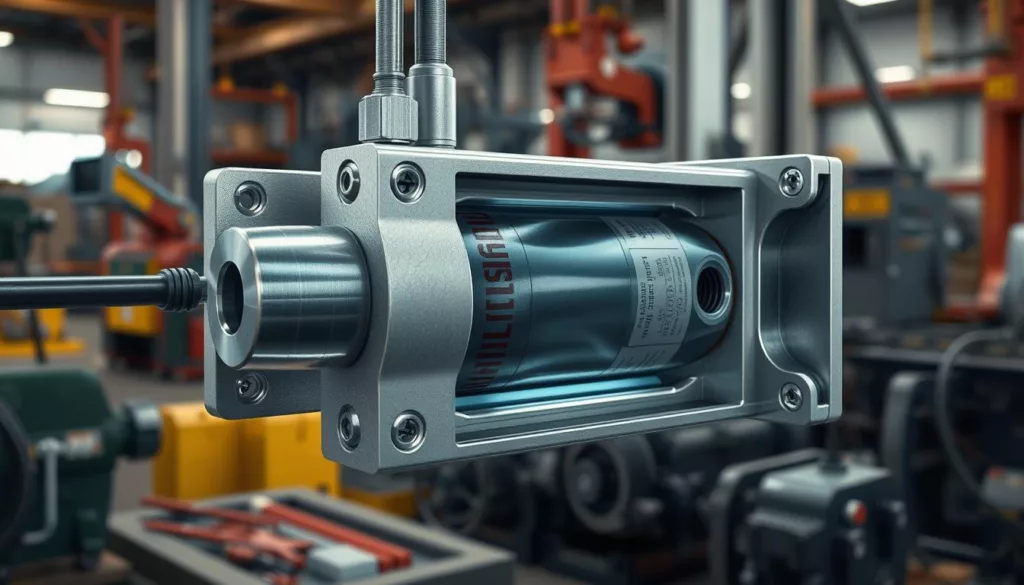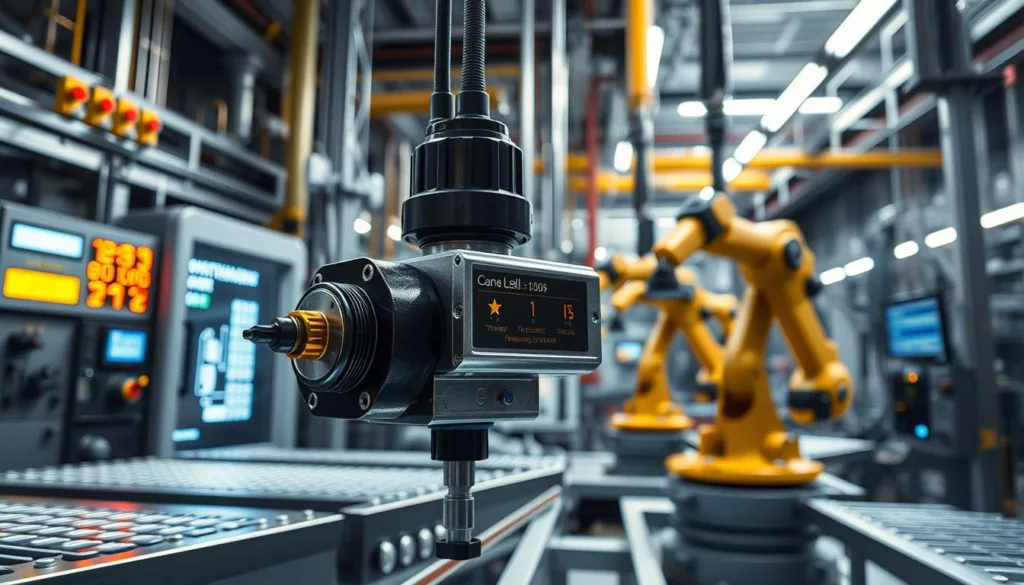In the world of industrial automation, precise force measurement is key. It ensures top performance, quality, and safety. Industrial tension sensors are at the core of this, turning mechanical force into electrical signals. They are vital for load cell applications, supporting many industrial processes.
This guide explores industrial tension sensors in depth. We’ll look at their basics, parts, and uses across different industries. If you’re in engineering, management, or procurement, knowing about these sensors is vital. It helps you use them to their fullest in your work.
Key Takeaways
- Industrial tension sensors are key in load cell applications, making accurate force measurement possible.
- They change mechanical force into electrical signals, giving important data for automation and process improvement.
- It’s important to install, calibrate, and integrate tension sensors correctly for reliable performance.
- New tech in digital signal processing, IoT, and data analytics has made tension sensors more powerful.
- Following safety standards and best practices is essential for safe and effective use of tension sensors.
Understanding Industrial Tension Sensors: Basic Principles and Functions
Tension measurement is key in many industrial processes. Industrial tension sensors are at the heart of this technology. They use advanced transducer technology to turn physical forces into electrical signals. This gives precise and reliable data for many uses.
How Tension Sensors Convert Force into Electrical Signals
At the core of these sensors is the strain gauge. It measures how much a material bends under force. This bending changes the gauge’s electrical resistance, showing the tension or load applied. This is how load cell technology works.
Key Components of Industrial Tension Sensors
- Strain Gauge: The main part that measures bending from force.
- Transducer Electronics: The part that changes the gauge’s resistance into a signal.
- Mechanical Structure: The part that holds everything together and transfers force to the gauge.
- Calibration and Compensation: These ensure the sensors work well under different conditions.
Operating Principles and Mechanical Design
Industrial tension sensors use transducer technology to turn forces into signals. Their design focuses on transferring tension to the strain gauge accurately. This mix of electronics and mechanics is key to reliable industrial tension measurement.
“Precision is the hallmark of industrial tension sensors, enabling manufacturers to monitor and control critical processes with unparalleled accuracy.”
Types of Load Cells Used in Industrial Tension Sensing
Load cells are key in industrial tension sensing, helping to measure loads accurately. They come in various types, each with its own benefits. Knowing about these options helps professionals choose the right one for their needs.
The strain gauge load cell is a common choice. It turns force into an electrical signal for precise load monitoring and weight sensing. Known for reliability, accuracy, and durability, they’re often used in industrial weighing systems.
Hydraulic load cells are also popular for tension sensing. They use a hydraulic system for measuring force, providing great linearity and repeatability. They’re ideal for high-capacity, high-accuracy needs, like in heavy machinery and industrial equipment.
| Load Cell Type | Key Features | Typical Applications |
|---|---|---|
| Strain Gauge Load Cell | Reliable, accurate, and durable | Industrial weighing systems, material handling, process control |
| Hydraulic Load Cell | High capacity, high accuracy, exceptional linearity | Heavy machinery, industrial equipment, crane and lifting applications |
| Piezoelectric Load Cell | Fast response time, high-frequency capabilities | Dynamic force measurement, impact testing, vibration analysis |
Piezoelectric load cells are another common choice. They use the piezoelectric effect to create an electrical signal from force. This allows for fast response and precise measurement of dynamic forces.
Understanding the different load cell types helps professionals make better choices. This ensures accurate and reliable performance in their industrial processes.
Industrial Tension Sensor for Load Cell Applications: Implementation and Setup
Setting up industrial tension sensors for load cell applications needs careful planning. You must consider installation, calibration, and system integration. By doing this, professionals can make sure their tension measurement systems work well and accurately.
Installation Requirements and Best Practices
Installing industrial tension sensors right is key for their good work. Think about where to place them, how to mount them, and the environment they’ll be in. Follow the maker’s advice and industry rules to get a solid setup that cuts down on errors.
Calibration Procedures and Accuracy Optimization
Calibrating these sensors is vital for getting exact and steady readings. It means adjusting the sensor to match known loads, so you get right tension numbers. Doing this often keeps your precision load cells and tension measurement at top performance.
System Integration Guidelines
Putting industrial tension sensors into big industrial automation systems needs smart planning. You have to think about data sharing, signal handling, and making sure they work with other parts. Following these guidelines helps users get the most out of their tension measurement systems.
“Proper implementation and setup of industrial tension sensors are key for accurate and reliable tension measurement in many industrial uses.”
Benefits of Tension Measurement in Industrial Processes
The use of force sensing and load monitoring in industrial systems brings many advantages. It helps businesses in different fields improve quality, work more efficiently, and keep their workplaces safe.
One key benefit is getting accurate, real-time data on forces applied to important parts or materials. This helps manufacturers adjust their methods, spot problems early, and keep their products consistent and high-quality.
Also, tension sensors help make processes more automated and controlled. This leads to more work done and less time lost. By watching force levels closely, workers can quickly fix any issues, keeping the production line running well.
Another big plus is safety. Tension sensors warn of too much force or sudden changes. This prevents equipment breakdowns, accidents, and injuries, protecting people and things.
In summary, tension measurement does more than just collect data. It helps businesses work better, keep quality high, and create a safer place to work. This leads to better profits and happier customers.
“Tension measurement is a critical component in modern industrial processes, enabling businesses to optimize performance, enhance quality, and prioritize safety.”
Applications Across Different Industries
Industrial tension sensors are used in many industries. They are key in making sure things work well and efficiently. This includes manufacturing, production lines, material handling, and special uses in textiles and wires.
Manufacturing and Production Lines
In manufacturing, these sensors keep an eye on material tension. They help make sure products are the same quality every time. This means less waste and better work flow.
They check the tension in metals, fabrics, and paper. This stops problems like wrinkles and breakages. It also makes sure materials are evenly spread out.
Material Handling and Conveyor Systems
These sensors are also important for moving materials around. They watch the tension in conveyor belts. This keeps the belt running smoothly and prevents damage.
This is important for keeping materials safe. It also stops the conveyor from breaking down. This saves time and money.
Textile and Wire Industry Applications
The textile and wire industries use these sensors in special ways. In textiles, they check the tension of yarns and fabrics. This makes sure fabrics are the right thickness and texture.
In wire making, sensors control the wire’s tension. This ensures the wire meets high quality standards.
These sensors are very useful in many industries. They help make products better and work more efficiently. This is good for businesses and quality control.
Maintenance and Troubleshooting Guidelines
Keeping your industrial tension sensors in top shape is key for steady and precise tension measurement and force sensing. At XJCSENSOR, we offer detailed maintenance and troubleshooting tips. These are designed to extend the life and reliability of your precision load cells.
Proactive Maintenance Practices
To keep your industrial tension sensors working at their best, follow these steps:
- Check sensor parts for wear or damage, like cracks, corrosion, or loose connections.
- Calibrate your tension sensors as the maker suggests to get precise force sensing data.
- Keep the sensor area clean and free of dirt, as it can harm sensor performance.
- Shield the sensors from harsh weather, like too much heat, cold, or shakes, which can damage them.
Common Troubleshooting Steps
If you run into problems with your industrial tension sensors, try these steps to fix the issue:
- Make sure the sensor is hooked up right to power and data systems.
- Look for any damage or blockages that might be messing with the sensor’s work.
- Double-check that the sensor is calibrated right and giving correct tension measurement data.
- Check the sensor’s settings and the environment it’s in to see if there’s a problem.
- If the problem doesn’t go away, reach out to the maker’s tech support or get a new precision load cell.
By sticking to these maintenance and troubleshooting tips, you can make sure your industrial tension sensors work well. This ensures you get reliable force sensing data for your important industrial tasks.
Advanced Features and Technology Integration
In the world of industrial [industrial automation], [transducer technology] has grown a lot. It now gives sensors new, advanced abilities. Micro load cells are leading this change, adding [load monitoring] features to improve their work.
Digital Signal Processing Capabilities
Micro load cells use advanced digital signal processing (DSP) algorithms. These algorithms help measure and analyze force and tension data accurately. This means they can monitor in real-time, remove noise, and give precise readings, even in tough environments.
IoT Connectivity and Remote Monitoring
The rise of [industrial automation] has brought a new level of connectivity. Micro load cells can now connect to the Internet of Things (IoT). This lets users check important data and insights from anywhere, making maintenance and operations more efficient.
Data Analytics and Predictive Maintenance
Micro load cells use advanced data analytics now. They turn raw data into useful information. With algorithms and machine learning, they can spot problems, predict failures, and help plan maintenance. This reduces downtime and boosts productivity.
“Embracing these cutting-edge features in micro load cells empowers our customers to unlock new levels of [industrial automation] efficiency and reliability.”
XJCSENSOR is always leading in [transducer technology], bringing new micro load cell solutions. We use digital signal processing, IoT, and data analytics. This helps our customers improve their [load monitoring] and stay ahead.
Safety Considerations and Compliance Standards
Safety is key in industrial weighing systems and load cell applications. XJCSENSOR’s tension sensors follow strict safety rules for reliable and safe use in different industrial places. They meet high standards set by groups like the Occupational Safety and Health Administration (OSHA) and the International Electrotechnical Commission (IEC).
Our tension measurement solutions are made to follow strict safety rules. This includes meeting OSHA’s Hazardous Locations standards and the IEC’s Explosive Atmospheres (ATEX) rules. These standards mean our products are safe in dangerous places, protecting people and equipment from electrical or mechanical failures.
XJCSENSOR also focuses on adding safety features to our tension sensors. We use strong housing, extra safety steps, and advanced checks to keep an eye on the sensor’s work. This way, we help make sure our tension measurement systems are safe and reliable for use in important industrial processes.






